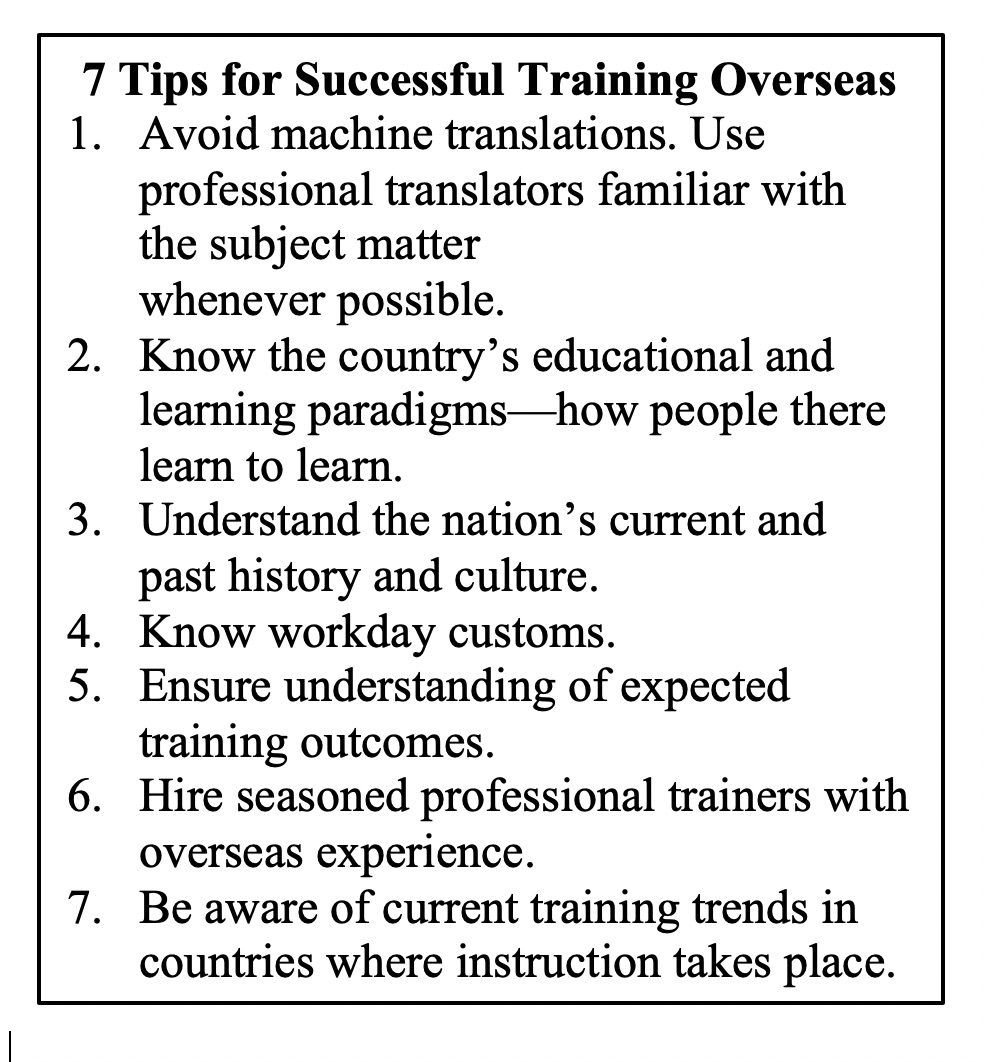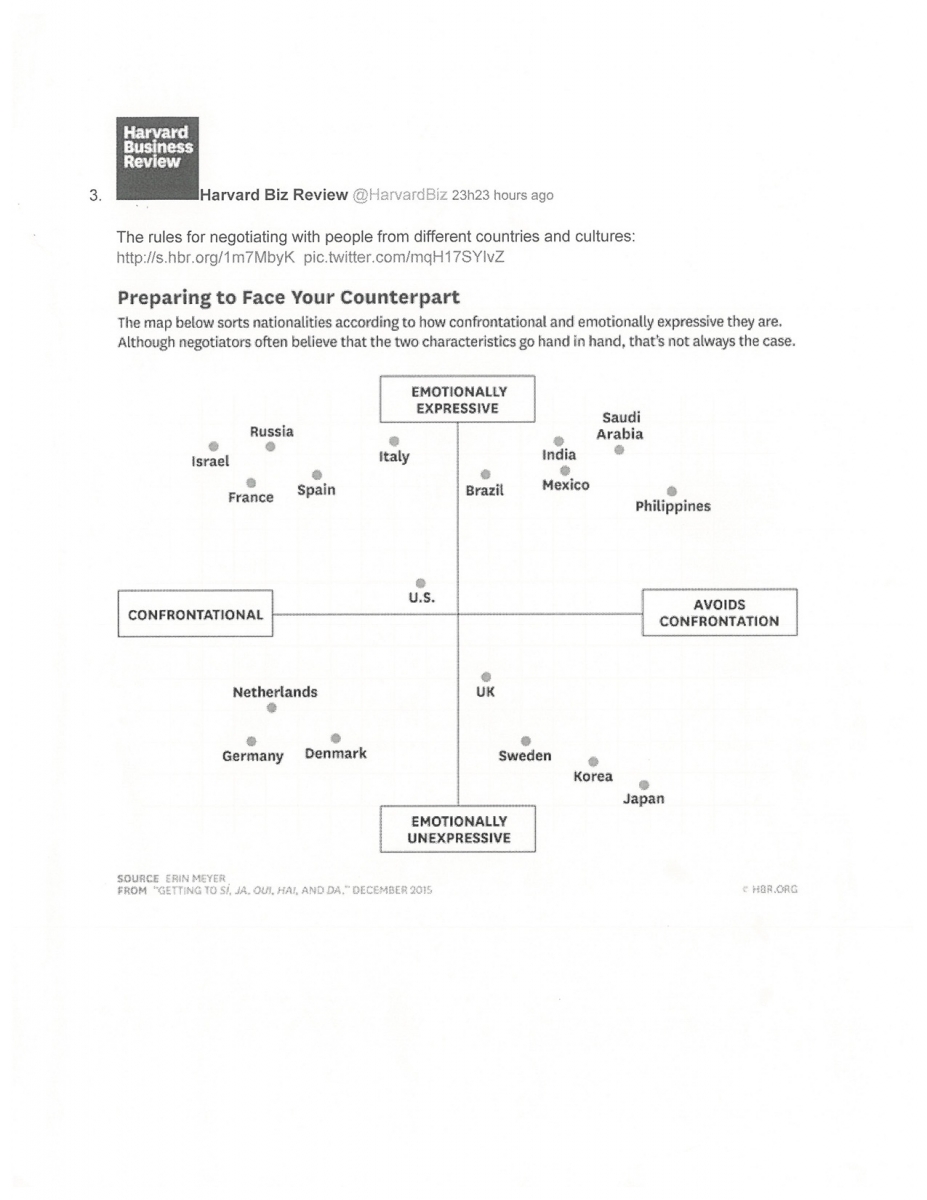Many U.S. multinational companies get their overseas training wrong. One of the main reasons this occurs is that often both the purchaser and the trainer selected have little experience training overseas. Sometimes the trainer and the content have not been prepared sufficiently (or at all) to meet the language and learning culture of the overseas target audience. As a result, training efforts will not be optimized and can be a wasted investment.

For the best results, international corporate trainers need to do their language and cultural homework ahead of time and know where to look for the best resources. Teaming up with local facilitators (or at least speaking with one) can be invaluable to ensure the translation and the training are culturally adapted to local business practices. Precision in language matters significantly for multinational organizations seeking performance improvement, whether through a digital platform or in-person. In particular, face-to-face communication should take into account such variables as age, social mores, and confrontational and emotional expressiveness.
Tips for Better Training Results
Beyond language challenges, there are many other variables that can make a training program fail. To get the desired results from global training initiatives, here are seven key tips to address in preparing for overseas training delivery
Tip #1: Avoid machine translations (i.e., Google Translate) of training materials. They almost never work. Beyond that, even a local translator has to have hands-on knowledge about the subject matter to address industry- or profession-specific terms. Even professional translations should be retranslated back to English to ensure they express the intended message.
Tip #2: Know the country’s educational and learning paradigms. Does the country’s academic system train students to learnby rote or by asking questions? Do the students expect trainers to give them a formula and not to question them to see if they can discover the answers? Are students and employees accustomed to learning in classrooms, large lecture halls, or small interactive groups? Corporate trainers will be most successful when they take the learning preferences of the foreign country’s people into account.
Tip #3: Understand the culture of the country before starting the training. There are two components to culture: traditional country culture and the business culture of the country. To understand the current country culture, instructors can watch the country’s news shows (provided they are in English) via the Internet, and they can interview company employees who are living in the country via Skype. Trainers will learn past culture by studying the history of countries in which they will be working. This appreciation comes through in how the trainer demonstrates situational awareness, which can increase the trainees’ trust in the trainer. The result: Attention and learning rise commensurately.
Tip #4: Know workday customs. Companies and countries have various “rules” for working hours and work breaks, male-female interaction, privacy, body language, facial expressions, dress code, eating habits, and more. Many are not documented anywhere or may recently have changed. The trainer who is aware of these will generate better results from training—avoiding business and cultural faux pas. The instructor can learn from resources such as “Doing Business in _____(country)” books and will need to understand how trainees’ age, industry, topic, and skill set dictate the type of training to implement.
Today’s most effective trainers are flexible and know how to adapt workshops to spaced intervals, pacing, and unique delivery systems. These could be weekly trainings, classroom presentations, or 5-minute mobile phone YouTube modules, depending on the audience and local management requests. Successful instruction should be meaningful, fun, and memorable. Fun, however, does not mean funny. Remember, other countries have different ideas about humor. Don’t expect a joke that works in Chicago to be understood in Beijing.
Tip #5: Ensure that both trainers and trainees know what results are expected and how they will be measured and communicated. “What gets measured gets improved.”—Peter Drucker
Tip #6: Hire seasoned professional trainers whenever possible. Giving overseas assignments as a perk usually backfires. Training overseas requires much more than translating the words and delivering off-the-shelf packages verbatim. Because training is so expensive, it is not worth leaving it in the hands of non-professionals, who, for example, might not realize that talking about politics or religion is ill-advised.

Tip #7: Be aware of current training trends in each country. Trainers need to adapt and modify their sessions to demonstrate awareness of and support a prevailing trend. For example, “storytelling” is popular right now in many countries. Leadership training, for example, might open with a business story to present a concept leaders can relate to, follow, and use the next business day.
No Global Language
It is easy to think that everyone doing business in this fluid, global marketplace speaks the language of commerce, but that’s not the case. Well-meaning, multinational training managers acknowledge cultural and linguistic differences but still are tempted to buy off-the-shelf training packages in U.S. English. They may have them translated with the aid of machine translators into the foreign country’s primary language, but that does not work. Spanish spoken in Madrid and Spanish in Mexico City or Buenos Aires will have differences. Even regional dialects and vocabulary within countries can materially influence training content and delivery. Consequently, the intended learning isn’t fully achieved, and the return on investment in the training is not maximized.
Training to achieve performance improvement, whether for sales, management, technology, or almost any discipline, can increase profits. Language translation alone is not sufficient. Multinational companies should prepare instructors and translate their training materials carefully because it is an unfortunate and avoidable waste of money when they get it wrong.
Jon Gornstein is the founder and president of Persona Global, an international industry pioneer in performance improvement in areas related to leadership, change management, negotiations, and communications. Based in Sausalito, CA, the company offers workshops, online business simulations, and business board games in as many as 38 languages. Programs are distributed through the company’s branded offices or certified trainers in partner companies in 71 countries. For more information, visit: www.personaglobal.com




